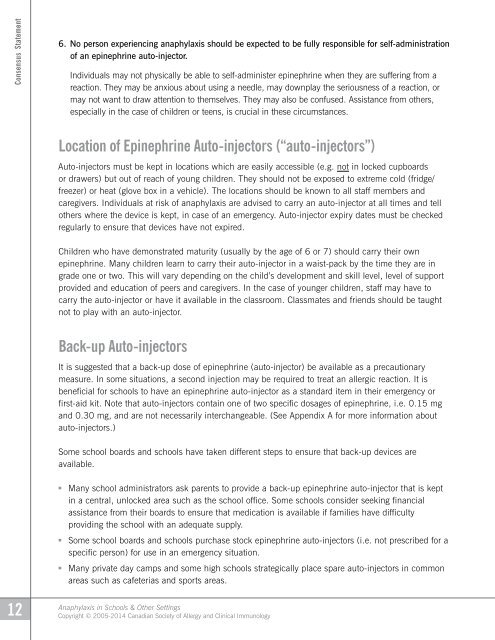Anaphylaxis in Schools 3rd Edition
Anaphylaxis in Schools 3rd Edition
Anaphylaxis in Schools 3rd Edition
Create successful ePaper yourself
Turn your PDF publications into a flip-book with our unique Google optimized e-Paper software.
Consensus Statement<br />
6. No person experienc<strong>in</strong>g anaphylaxis should be expected to be fully responsible for self-adm<strong>in</strong>istration<br />
of an ep<strong>in</strong>ephr<strong>in</strong>e auto-<strong>in</strong>jector.<br />
Individuals may not physically be able to self-adm<strong>in</strong>ister ep<strong>in</strong>ephr<strong>in</strong>e when they are suffer<strong>in</strong>g from a<br />
reaction. They may be anxious about us<strong>in</strong>g a needle, may downplay the seriousness of a reaction, or<br />
may not want to draw attention to themselves. They may also be confused. Assistance from others,<br />
especially <strong>in</strong> the case of children or teens, is crucial <strong>in</strong> these circumstances.<br />
Location of Ep<strong>in</strong>ephr<strong>in</strong>e Auto-<strong>in</strong>jectors (“auto-<strong>in</strong>jectors”)<br />
Auto-<strong>in</strong>jectors must be kept <strong>in</strong> locations which are easily accessible (e.g. not <strong>in</strong> locked cupboards<br />
or drawers) but out of reach of young children. They should not be exposed to extreme cold (fridge/<br />
freezer) or heat (glove box <strong>in</strong> a vehicle). The locations should be known to all staff members and<br />
caregivers. Individuals at risk of anaphylaxis are advised to carry an auto-<strong>in</strong>jector at all times and tell<br />
others where the device is kept, <strong>in</strong> case of an emergency. Auto-<strong>in</strong>jector expiry dates must be checked<br />
regularly to ensure that devices have not expired.<br />
Children who have demonstrated maturity (usually by the age of 6 or 7) should carry their own<br />
ep<strong>in</strong>ephr<strong>in</strong>e. Many children learn to carry their auto-<strong>in</strong>jector <strong>in</strong> a waist-pack by the time they are <strong>in</strong><br />
grade one or two. This will vary depend<strong>in</strong>g on the child’s development and skill level, level of support<br />
provided and education of peers and caregivers. In the case of younger children, staff may have to<br />
carry the auto-<strong>in</strong>jector or have it available <strong>in</strong> the classroom. Classmates and friends should be taught<br />
not to play with an auto-<strong>in</strong>jector.<br />
Back-up Auto-<strong>in</strong>jectors<br />
It is suggested that a back-up dose of ep<strong>in</strong>ephr<strong>in</strong>e (auto-<strong>in</strong>jector) be available as a precautionary<br />
measure. In some situations, a second <strong>in</strong>jection may be required to treat an allergic reaction. It is<br />
beneficial for schools to have an ep<strong>in</strong>ephr<strong>in</strong>e auto-<strong>in</strong>jector as a standard item <strong>in</strong> their emergency or<br />
first-aid kit. Note that auto-<strong>in</strong>jectors conta<strong>in</strong> one of two specific dosages of ep<strong>in</strong>ephr<strong>in</strong>e, i.e. 0.15 mg<br />
and 0.30 mg, and are not necessarily <strong>in</strong>terchangeable. (See Appendix A for more <strong>in</strong>formation about<br />
auto-<strong>in</strong>jectors.)<br />
Some school boards and schools have taken different steps to ensure that back-up devices are<br />
available.<br />
• Many school adm<strong>in</strong>istrators ask parents to provide a back-up ep<strong>in</strong>ephr<strong>in</strong>e auto-<strong>in</strong>jector that is kept<br />
<strong>in</strong> a central, unlocked area such as the school office. Some schools consider seek<strong>in</strong>g f<strong>in</strong>ancial<br />
assistance from their boards to ensure that medication is available if families have difficulty<br />
provid<strong>in</strong>g the school with an adequate supply.<br />
• Some school boards and schools purchase stock ep<strong>in</strong>ephr<strong>in</strong>e auto-<strong>in</strong>jectors (i.e. not prescribed for a<br />
specific person) for use <strong>in</strong> an emergency situation.<br />
• Many private day camps and some high schools strategically place spare auto-<strong>in</strong>jectors <strong>in</strong> common<br />
areas such as cafeterias and sports areas.<br />
12<br />
<strong>Anaphylaxis</strong> <strong>in</strong> <strong>Schools</strong> & Other Sett<strong>in</strong>gs<br />
Copyright © 2005-2014 Canadian Society of Allergy and Cl<strong>in</strong>ical Immunology


